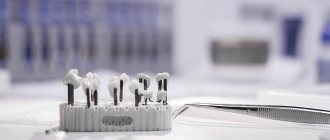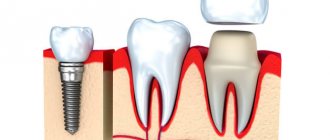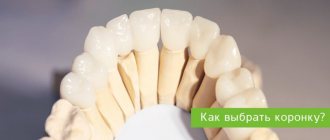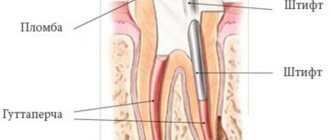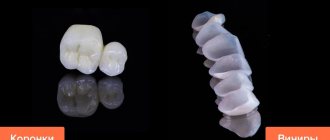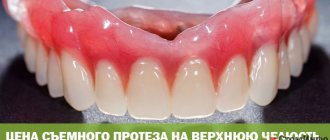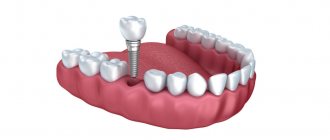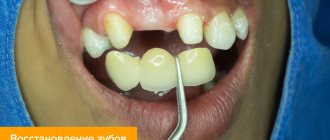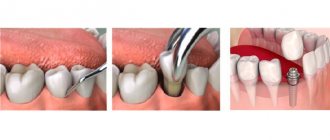For many people, losing multiple teeth seriously impacts their quality of life. At the same time, the patient is often at a loss before choosing which type of prosthetics he prefers and what is better for him: a bridge or an implant? We propose to weigh all the possible “pros” and “cons” of both methods of prosthetics, answering all possible important questions.
What are bridges and dental implants?
A bridge is a permanent dental prosthesis consisting of crowns welded together, the outermost of which are fixed on previously ground living teeth. Used to restore 1-4 missing units in a row. The number of support units is always two. Bridges are usually created from the following materials: metal ceramics, zirconium dioxide. We install only metal-free structures.
Dental implants are artificial analogs of tooth roots that act as supports for individual crowns or dentures. Manufactured from medical titanium, biocompatible with oral tissues. Indicated for single, partial and complete edentia. They are implanted into the jaw using the following methods: classic, express, simultaneously with tooth extraction. They fully restore the functions and aesthetics of the dentition.
Pros and cons of implantation
The ideal orthodontic design is created taking into account high aesthetic parameters, especially for the front teeth. And first of all, its functionality must be taken into account. So, an artificial rod with a crown is precisely the only system that meets these requirements. It is tightly fixed in the bone, which prevents atrophy of hard tissues, withstands good chewing load, does not negatively affect the aesthetic properties of the gums, and looks like a natural tooth.
With careful care, a titanium rod will serve patients for a lifetime. And the crown, unfortunately, has to be changed after ten to fifteen years. The bone tissue is loaded evenly and correctly, which prevents loss of its volume, which bridges cannot do. It is worth considering that the absence of a unit for a long time causes displacement of neighboring organs. And then, when installing the rod, it will be necessary to build up the bone and turn the bent unit. This situation is fraught with changes in the oval of the face and bite, drooping of the corners of the lips, the appearance of nasolabial folds, not to mention problems with chewing food. Therefore, to avoid all this, consult a doctor on time!
The ideal aesthetic effect is achieved by working not only with hard tissues, but also with gingival tissues. Removal of the units is usually combined with the placement of an artificial rod. This preserves the shape and color of the soft tissues. More detailed information can be found at the link Single-stage dental implantation. In this case, the patient should not have inflammation, but there should be sufficient bone volume. In such a situation, neighboring healthy teeth will not be harmed in any way. Another advantage is that it is possible to restore not only single teeth, but also the jaw with general edentia. Only a few rods are implanted, and that is enough.
As for the shortcomings, there are practically none. True, there are contraindications. The ban applies to patients with severe cardiovascular diseases, serious diseases of the blood, liver, and connective tissue. The procedure is not prescribed for clients with thyroid pathology, mental disorders, allergies to antiseptics and antibiotics. Implantation is not performed if you are taking bisphosphonates systematically, which affect bone structure. But there is good news: in modern dentistry, the list of prohibitions depends on the installation technology.
Pros of the methods
If we compare both options, then both the bridge and the implant are non-removable structures, matched to the color and shape of the patient’s natural teeth, and restore the functionality of the dentition. However, each method has individual advantages.
Pros of bridges on your teeth:
- shortened treatment periods;
- minimum contraindications;
- affordable price.
Advantages of implants:
- functional, aesthetic;
- allow you to restore any number of lost units;
- suitable for restoring terminal defects of the dentition;
- prosthetics with single crowns, bridges and complete dentures;
- have increased stability;
- distribute the load evenly, protect the jaw bone from resorption;
- crown replacement is performed without removing the titanium root;
- have a lifetime service life (for Nobel Biocare models).
The main advantage of implants compared to classic bridges is that to install the prosthesis, it is not necessary to grind down the units adjacent to the defect.
Implant or removable denture?
If all teeth are missing, you will be offered removable dentures or dentures on implants. Implants or removable dentures?
Pros and cons of removable prosthetics and implant prosthetics (click to expand):
| Complete removable denture | Dental implantation |
Advantages
| Advantages
|
Flaws
| Flaws
|
Other options for conditionally fixed prosthetics (mini-implantation, All-on-4 implantation) are used in cases where it is not possible to use the classic two-stage implantation protocol. You can learn more about these types of implantation here. During their student years, young chicks get up to various pranks with their anals, which no one has even dreamed of and which are known only to a small circle of people. Immerse yourself in this esotericism and watch anal sex with a student that will not be forgotten for a long time. Feel like part of a drunken party where a young chick is fucked by several dicks at once, testing the stretchability of her ass in excellent HD quality.
Contraindications
Among the limitations to classical bridge prosthetics:
- diseases of periodontal tissues (periodontal disease, periodontitis);
- serious malocclusion;
- pathological abrasion of enamel;
- inflammation of the oral cavity;
- osteoporosis and other diseases of the jaw bone tissue.
Dental implants are contraindicated in the following cases:
- high blood pressure;
- blood diseases;
- malignant neoplasms;
- diseases of the cardiovascular, endocrine, nervous systems;
- uncompensated diabetes mellitus;
- mental disorders;
- HIV AIDS;
- tuberculosis;
- infectious processes in the body;
- gum disease;
- age up to 16 years.
Implantation is also not performed in case of relative contraindications - lactation and pregnancy in women, if the patient has bad habits (smoking, alcohol abuse, drug use).
Make an appointment with an implantologist
Restrictions on installing an artificial root
Implantation is indicated when a person is missing one or more teeth and there is significant destruction of the nearest ones. Dentists also advise installing artificial roots in cases where the patient is categorically against grinding down adjacent teeth. It is recommended to install an implant in cases where it is not possible to install a bridge.
Crowns should be placed in situations where:
- There is no protective layer of the tooth;
- Increased abrasion is observed;
- Most of the tooth is damaged by caries.
A crown differs from an implant in that the latter can be used to restore a lost tooth, while the former helps preserve a damaged one. The doctor chooses what is the best option in each specific case.
There are a number of absolute contraindications for installing an artificial root:
- Various neoplasms;
- Diabetes mellitus in a severe stage of development;
- Tuberculosis;
- Disturbances in the functioning of the nervous system;
- Various mental disorders;
- Blood diseases;
- Inflammatory diseases of an infectious nature, localized in the area of the mucous membranes of the mouth;
- Weakening of the immune system;
- Exacerbations of various chronic diseases.
When placing an implant, the doctor must take into account the condition of the hard tissues of the jaw and their integrity. If the last point is violated, an artificial root cannot be installed.
There are also a number of relative contraindications for implantation of a metal pin:
- Pregnancy, breastfeeding;
- Insufficient compliance with hygiene measures;
- Bite disorders, congenital jaw defects;
- Inflammatory processes in the gums;
- Excessive smoking, alcohol abuse.
When deciding to install a titanium root, you should take into account all these contraindications and consult with an experienced specialist. Only after all possible risks have been eliminated is prosthetics using a pin possible.
Possible complications
After installing the bridge, the patient may encounter the following problems:
- sensation of a foreign body in the mouth in the first 5-7 days;
- pain (if you have this symptom, we recommend that you consult a doctor);
- food getting under the prosthesis (in case of improper fixation of the structure);
- peeling off crowns (occurs with bruxism in a patient);
- exposure of the neck of the supporting unit.
Complications after implantation occur in less than 5% of clinical cases. Among them:
- bleeding (occurs when a patient has a blood clotting disorder);
- pain (in the first 5-7 days this is a normal reaction to surgery, after this period it is a reason to consult a doctor);
- seam divergence;
- perforation of the bottom of the maxillary sinus;
- damage to the mandibular nerve (accompanied by numbness);
- peri-implantitis (inflammation of the gum tissue around the implant);
- design rejection.
Implants are a profitable solution
Classic bridge prosthetics is less expensive than implantation. However, if you take into account the costs of depulping the supporting units before installing a bridge and the need to replace the prosthesis every 7 years (in the best case scenario), implants are a profitable solution. Titanium roots do not destroy healthy teeth and have a lifetime service life, and zirconium dioxide crowns will not require replacement for at least 20 years.
Levin Dmitry Valerievich
Chief physician, Ph.D.
How bridges and crowns are made and installed
Before installing a crown, a specialist will reduce the size of the molars and supporting teeth. This procedure is required to ensure that these elements are held firmly in place. Once the tooth has been prepared and reduced, an impression of it is made. An impression is required to make the correct size, shape of a crown or bridge. If the product is made of porcelain or ceramics, the doctor must also take into account the natural shade of the prosthesis, which will be close to the natural color of the patient’s teeth. Based on the impression, a prosthesis is made from the required base using special equipment. Before installing a permanent crown or bridge, a temporary prosthetic element is placed on the tooth. After the necessary period required for the manufacture of a permanent prosthesis has passed, the temporary product is removed and a permanent one is placed in its place.
A dental cast is an accurate impression of several teeth or the entire dentition, from which a model of the future prosthesis is cast from medical plaster. An orthopedist uses special equipment to create a denture design based on the impression obtained.
What is better to put on the front teeth?
Implantation is the best option when restoring anterior units. This is due to increased demands on aesthetics. The bridge initially corresponds to them, but gradually, due to atrophy of the jaw bone, it sags, becomes mobile, and a gap appears between it and the gum. The implant, on the contrary, preserves the healthy appearance of the gums and compacts the surrounding bone tissue. As part of the classical installation method, the formation of the correct gingival contour is additionally carried out. Aesthetics do not deteriorate throughout the entire service life of the structure.
Indications for installation of bridges
Let's look at situations where it may be recommended to replace missing teeth with bridges. Such indications may include:
- absence of teeth (one or more);
- financial difficulties that do not allow the patient to use dental implants;
- chronic diseases or conditions in which implantation is contraindicated (dystrophy of the jaw bone, pathology of the oral mucosa, general chronic diseases, etc.).
The main advantage of replacing missing teeth with bridges is that they are cheap and accessible to people of low income. However, due to a host of shortcomings, bridges are gradually giving way to more advanced types of prosthetics.
What to choose for a chewing tooth
In this case, the bridge and the implant have their own advantages and disadvantages. A bridge allows you to quickly restore the functionality of the dentition and cope with the chewing load normally. However, uneven distribution of pressure gradually leads to destruction and removal of supporting teeth.
The implant does not have a destructive effect on neighboring units; in all respects it is identical to a natural tooth. However, when installing a titanium root in the masticatory region, loading with a full-fledged prosthesis is not allowed until the artificial root has completely engrafted.
Is it possible to put a bridge on an implant?
Installation of a bridge is preferable when there are at least 4-6 natural teeth
Installation of a bridge is preferable when there are at least 4-6 natural teeth, but 8-10 are better in each row of the jaw.
However, this does not happen so often, so it is technically possible to fix the bridge structure to the implant.
At the same time, it cannot be said that two dentures installed at the edges of the dentition will be sufficient.
For reliable fastening, you will need to install several supports. This will make it easier to maintain the structure later and make it less vulnerable in operation.
In the absence of teeth, implants are installed on the jaw to act as supports. You will need from 6 to 10 pieces. This approach allows you to split a single bridge into 2-3 small prostheses, which will simplify its use and hygiene procedures.
Reference! According to scientific studies conducted by leading specialists from major clinics, it is not recommended to install a solid bridge on the lower jaw. The inability to monitor the oral cavity more carefully creates many problems.
Clinical cases
- If one tooth is missing . When restoring a single defect, the condition of neighboring units is taken into account. If they are healthy, it is better to choose implantation, since bridge prosthetics involves depulping the supporting teeth. If they are already pulpless, you can install a bridge.
- If several teeth are missing in a row . The choice of method depends on the extent of the defect. A bridge can restore no more than four missing teeth in a row. Implants - any quantity. In this case, it is not necessary to place a separate rod in place of each lost unit. There are options to fix a smaller number of titanium supports and cover them with a bridge. A bridge on implants does not destroy healthy teeth, the load is distributed evenly, and jawbone loss is eliminated. Plus treatment is cheaper.
- End defect . If the outermost teeth in a row are lost, the only option is implantation, since to fix the bridge at the edges of the defect there must be two supports.
Kinds
The history of dental prosthetics has been traced back to the times of the pharaohs. Representatives of the rich classes installed teeth taken from their slaves, using silver and gold for fixation.
Modern dentistry is rapidly developing thanks to the introduction of innovative technologies and materials. This contributes to the expansion of types of prostheses.
Types of implants
Let's take a closer look at the types of implants:
- Root – structurally, the implant exactly imitates a natural tooth. It is divided into varieties according to shape: cylindrical and screw. The first type has a porous structure, due to which the part is retained in the bone tissue and takes root in it. The screw implant is fixed due to the presence of threads.
- Intramucosal - intended for those who wear removable dentures on the upper jaw, which is often associated with atrophy of the alveolar process. One end of the product enters the oral mucosa, the other is fixed to a removable denture.
- Endodontic – is a pin that is screwed inside a natural tooth that has begun to loosen.
- Endosseous - the design is quite miniature and is not super reliable, but in the case of thin bone tissue it is most suitable. The installation process of such a part is labor intensive.
- Subperiosteal is a very complex system, both in manufacturing and installation. A special feature is the absence of the need to drill the bone before fixation.
- Combined - represents a design that combines several other installation principles.
- The mini-implant is part of a removable system. Used as a support, fixing individual elements of the prosthesis.
Types of Dental Implants
Types of dental bridges
The classification of bridge structures is carried out according to several criteria (material, shape of the structure, etc.), but the distinctive feature of the types is the methods of fixation:
- installation on healthy abutment teeth;
- fixation on implants;
- fastening with locks (clasp bridge);
- secured with adhesive materials.
Types of bridges
What is better - dental implantation or bridge?
For a clear example of the strengths and weaknesses of both options, we provide a comparative table.
| Bridge | Implant | |
| Number of missing teeth | 1-4 | any quantity |
| Degree of mastication recovery | average | full identity to a natural tooth root |
| Aesthetics | average | high |
| Recovery time | up to 1 month | 4-6 months, with bone grafting - up to 1 year |
| Difficulty of installation | average | complex |
| Impact on adjacent teeth | subject to depulping and turning | are not used |
| Jaw bone loss | intense | absent |
| Reliability of fixation | mobility of supports is possible in case of diseases and inflammation of periodontal tissues | complete immobility |
| Difficulty of care | Difficulties arise when food gets under the prosthesis | does not require special care |
| Restrictions on food intake | increased load excluded | any load is allowed |
| Comfort while wearing | There is discomfort in the first days after installation | complete comfort |
| Life time | up to 7 years, depending on the condition of the support units | implant - for life, prosthesis - 15 years or more |
| Price | Average | High |
Our dentists recommend that patients do not delay the restoration of missing teeth. Without load, the jawbone begins to atrophy. The method of filling a gap in the dentition must be decided quickly. Each patient, taking into account his financial capabilities, makes his own decision - whether it will be a bridge or an implant.
What is an implant
An implant is a prefabricated structure for prosthetics, consisting of several elements:
- artificial root - made of durable titanium alloy;
- abutment - the junction of the root and crown;
- a crown that is fixed to a pin.
Installation of modern dental implants is a common method of restoring the integrity of the dentition. The process consists of a set of procedures, including:
- building up bone tissue to the required volume, if it is not enough;
- implantation of an artificial root and its engraftment;
- fixation of artificial crowns.
Implantation will require patience from the patient. It is important to note that the result is worth it - artificial teeth will fit perfectly into the dentition and will perform all the functions of natural teeth.
As a rule, implantation is used when there is no desire to install removable orthopedic structures. Many patients want to do without grinding healthy teeth.
We most often recommend to our patients the installation of an implant to replace each lost tooth. An artificial tooth does not have natural mobility, so when installing a fixed structure, the patient may experience discomfort.
Ask a Question
